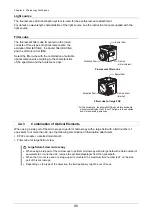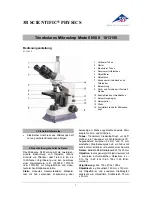
Chapter 4 Microscopy Techniques
87
4.3 Details of Diascopic DIC and IMSI Microscopies
4.3.1 Principles
of DIC Microscopy
DIC microscopy is a method of observing colorless,
transparent specimens such as living cells in an
unstained way using dia-illumination.
Objects that change the amplitude of light are called
amplitude objects (such as transparent objects, or
stained objects) and objects that change the phase
of light are called phase objects (such as colorless,
transparent specimens, or living cells). DIC
microscopy visualizes phase objects, which are
invisible to the human eye.
Visualizing phase objects
The illumination that has reached the specimen
changes the passing speed (phase) according to the
position (refractive index) where it passes the phase
object and the thickness (path length). If a polarizer
and a Nomarski prism are used, illumination can be
divided into two mutually perpendicular polarized
beams, each of which passes slightly apart
(hundreds of nm) from one another on a phase
object. By using a Nomarski prism and an analyzer
again to synthesize and cause interference between
the two polarized beams with their phase changed
according to the passing position, the contrast of
adjacent phases on the phase object can be
observed as the brightness of light.
DIC microscopy optical system
The DIC microscopy optical system is shown in the
figure on the right.
The light emitted from the light source is converted
into linear polarization (light that vibrates in only one
direction) on polarizing plate 1 (polarizer) and into
two beams with their mutually perpendicular
polarization planes on Nomarski prism 1. The
condenser lens converts the two beams into two
parallel beams, spaced slightly apart, and which then
pass through the specimen. This separation amount
(shear amount) is less than the resolution of the
objective, and therefore the two beams do not
produce a double image. The two beams are
collected onto the rear-side focal plane by the
objective and are formed into one beam by Nomarski
prism 2. However, if there is no phase contrast in the
passing position on the specimen, the beams are
blocked by polarizing plate 2 (analyzer) on which
polarizing plate 1 and the optical axis intersect at
right angles. If there is a phase contrast, a DIC
image having a bright and dark contrast due to
interference is formed.
Optical path diagram of DIC microscopy
Principles of IMSI Microscopy
IMSI (Intracytoplasmic Morphologically selected
Sperm Injection) is a DIC technique for selecting
sperms suitable for micro insemination. This
microscopy is aimed at achieving improved fertility
rate and implantation rate through detailed
observation and selection of the head of each sperm
using high-magnification DIC images.
Light source
Collector lens
Field diaphragm
Field lens
Aperture diaphragm
Condenser lens
Polarization
direction of light
Polarizing plate 1
(polarizer)
Nomarski prism 1
Specimen
Objective
2nd tube lens
Image plane
Nomarski prism 2
Polarizing plate 2
(analyzer)
















































